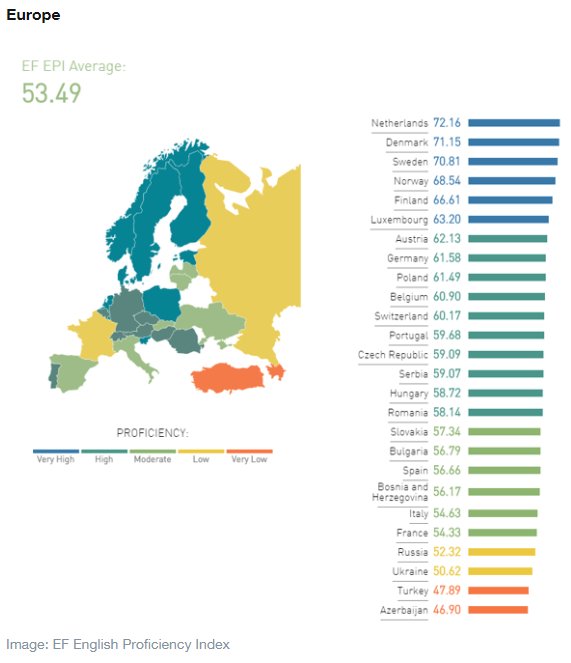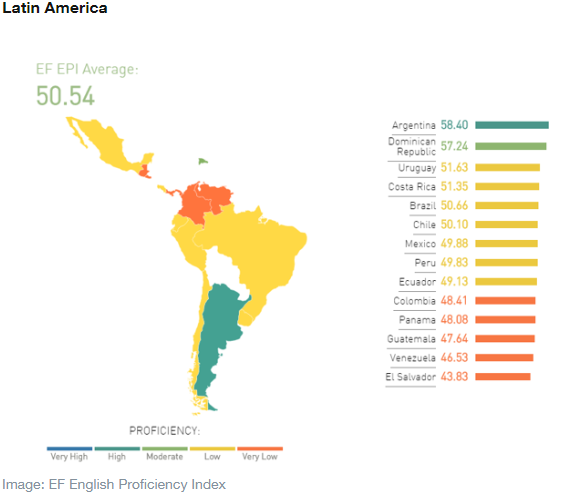It can be difficult to raise a bilingual child, but the benefits of learning a second language at an early age are certainly worth the struggle.
Bilingual children learn faster and easier, have improved problem solving skills and creativity, and have more career opportunities in adulthood. They also find it easier to connect with other cultures which makes them more open-minded and tolerant of diversity, and they are less likely to experience age-related mental illness as they reach old age. Most importantly, it’s much easier to learn a second language at an early age.
In addition, learning a second language isn’t as difficult as it used to be. Scientists are constantly studying second language acquisition and developing new methodologies to help kids learn faster. And, the rising demand of language programs has created a whole new market of international summer camps with language classes where kids can enjoy their favorite activities and learn a new language at the same time. Check out these international camps:
If you are looking for a Spanish language program but don’t have the option to travel abroad we can highly recommend the online live Spanish courses offered by Salamanca University or online Spanish courses offered by Malaga University. Another alternative for younger children is the language programs offered by foreignlanguagesforkids.com
The benefits of learning a second language at an early age
Learn faster and easier
Improve problem solving and creativity
Enhance future career opportunities
Connect with other cultures and build tolerance
Prevent age-related mental illness
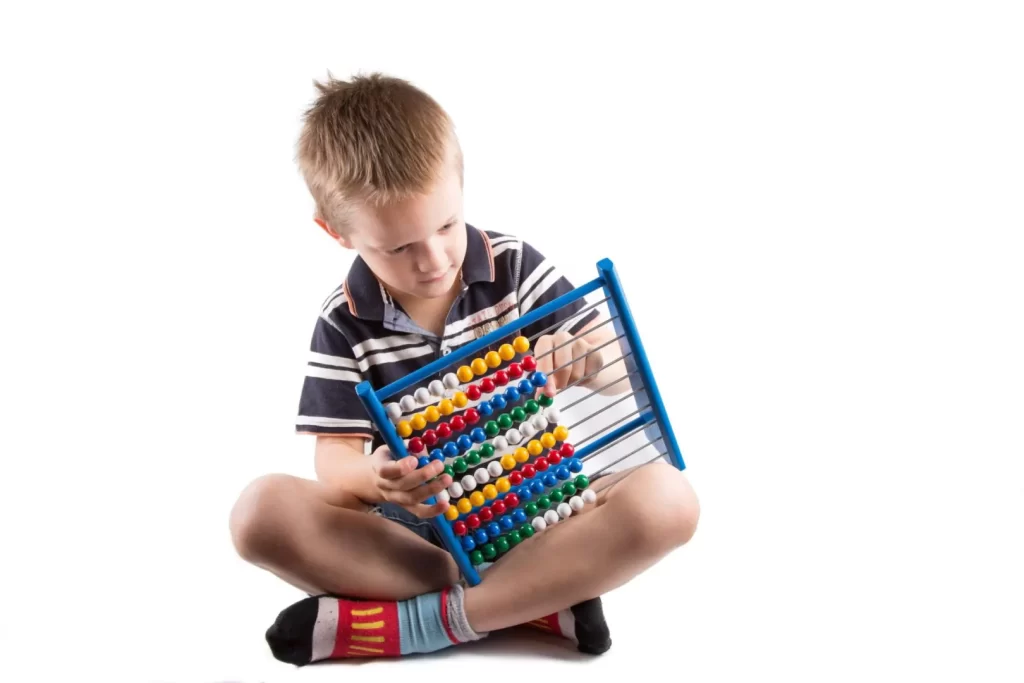
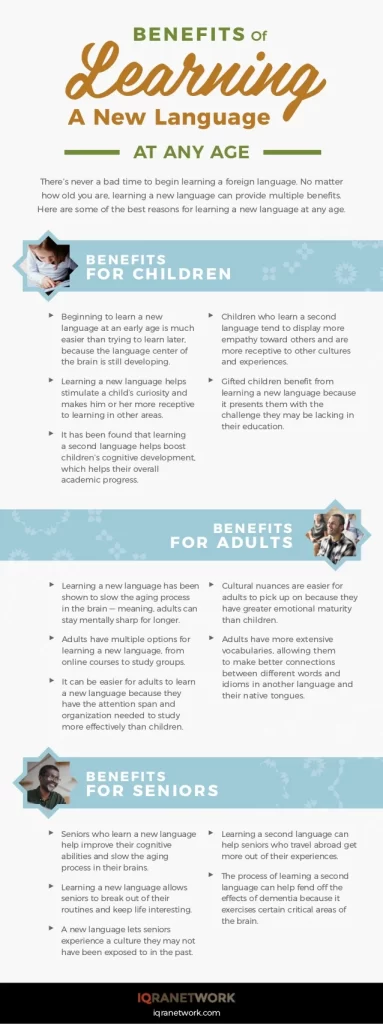
Benefits of learning a new language at any age. Created by IQRA Network
Learning a second language is easier as a child
One of the main benefits of learning a second language at an early age is that children learn languages faster and easier. They have more time to learn, less to learn, fewer inhibitions, and a brain designed for language learning. In short, teaching your child a second language at an early age saves them from having to learn a second language as an adult.
1. Brain structure facilitates second language-learning
On a biological level, children are like sponges. The brain of a child is designed to absorb new information unconsciously. They do this similarly to the way that we, as adults, unconsciously learn song lyrics, rhythms, and melodies. Dr. Paul Thompson, a neurology professor at UCLA, and his team found that the brain systems specialized in learning new languages grow rapidly from around six years old until puberty. Then these systems basically shut down and stop growing from ages 11 to 15, during puberty. Click HERE to read more about the study.

2. Baby brains have special skills for second language-learning
Take a look at this TED Talk where Patricia Kuhl explains how babies listen to the sounds around them and “take statistics” on the sounds they need to know. Before the age of 10 – 12, babies can differentiate between all sounds across all languages. Then, according to their exposure to languages, they start to only differentiate between the language sounds which are necessary to create meaning. The Japanese language does not diferentiate between the l and the r sounds. Japanese babies before 10 months old, can hear the difference between these sounds. Then, between 10 and 12 months old, they lose their capacity to differentiate.
Can babies learn a new language with radio and television? Or do they need real human interaction to absorb a new language? Skip to minute 7:05 to find out.
3. Children have less to learn than adults
Another one of the benefits of learning a second language at an early age is that children think more simply than adults. They use fewer words, simpler sentence structures, and think less abstractly. Children who are learning a second language are not overwhelmed by the task of communicating their abstract thoughts and feelings in their second language because they simply don’t have any. Then, as these children develop into adults, they learn to express themselves in both their native and second languages. Adults, on the other hand, must face the daunting task of translating complex sentence structures and abstract thoughts to be able to fully express themselves in their second languages.
Combine LANGUAGE STUDY + SPORTS
Check out these tennis camps complete with Spanish classes!
4. Children have time on their side
Think about the books you read as a child compared to the books you read now. Remember it took years of schooling and required reading to be able to understand the texts you can read now. The same applies to writing, listening, and even speaking. It took at least 15 years of academic study to be able to communicate the way you do in your native language. Time is another one of the benefits of learning a second language at an early age. Children have time on their side. They can start small and simply and work their way up to both higher levels of thought and communication at the same time. Children have a great advantage over adults as second language learners.
Learning a second language prepares children to be expert problem solvers
Children who learn a second language grow up to be expert problem-solvers and creative thinkers. Their brains experience a constant workout from a young age as they try to sort out which language to speak and when. Researchers have found that in addition to enhanced problem-solving skills, bilingual children are better at planning, conentrating, and multi-tasking. And, they score higher on standardized tests. By teaching your child a second language at a young age, you are setting them up for success.
5. Learning a second language means a constant mental workout
Bilinguals are constantly experiencing a mental workout as they sort through more than one language system to communicate. In the 20th century, researchers and educators discouraged second language learning. A second language was thought to interfere with children’s intellectual and cognitive development. While there is evidence that bilingual children do experience this interference of language systems, it turns out that the internal conflict that bilingual children experience prepares them to be expert problem solvers. Click here to read the full article.
6. Learning a second language means improved executive function
Collective evidence from various studies demonstrates that learning a second language improves the brain’s executive function. This means, bilingual children are better at:
- Planning
- Problem solving
- Concentration
- Multitasking
An interesting study
In 2004, psychologists Ellen Bialystok and Michelle Martin-Rhee tested the problem-solving abilities of bilingual and monolingual preschoolers. All children were asked to sort blue circles and red squares on a computer screen in two digital bins – one marked with a blue square and the other with a red circle.

First, they were asked to sort the shapes by color putting the blue shapes in the blue bin and the red shapes in the red bin. Both children performed well.
Then, the preschoolers were asked to sort by shape placing the blue circles in the red circle bin and the red squares in the blue circle bin. This task required more concentration as the children had to place the shapes in a bin with a conflicting color. Bilingual children performed this task quicker.
7. Learning a second language leads to improved test scores
Another one of the many benefits of learning a second language at an early age is improved test scores. Students who study foreign languages perform better on standardized tests such as the American College Test (ACT) and the SAT verbal sections. In fact, students test scores improve with the length of time they have spent learning a second language.
Combine LANGUAGE STUDY + SPORTS
Check out these soccer camps complete with Spanish classes!
An interesting study

To read more research regarding the effect of learning a second language on academic performance, click HERE.
8. Learning a second language fosters creative thinking
A boost in creatively is another one of the benefits of learning a second language at an early age. Various studies have proven it.

One of the most used creativity tests is called the Torrance Tests of Creative Thinking (TTCT) created by Ellis Paul Torrance in 1962. These tests are designed to measure “divergent thinking” or thinking outside the norm, thinking creatively. Theymeasure participants’ divergent thinking in four areas: fluency, flexibility, originality, and elaboration.
Bilingual children score higher on the TTCT.
Take a look at some examples of TTCT test problems in the figure below:
Creativity testing examples
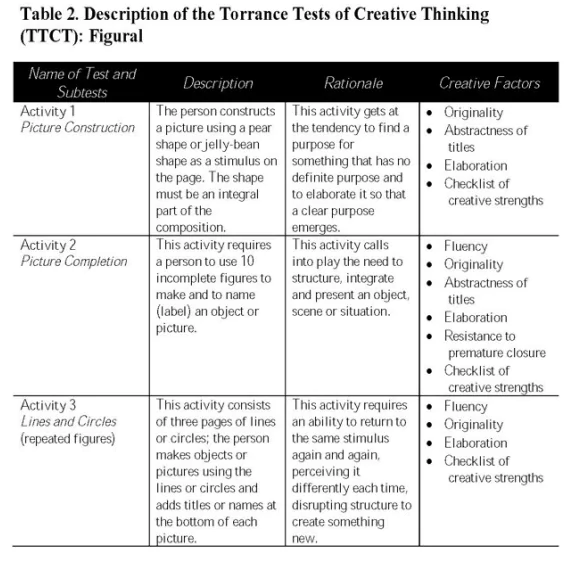
9. Learning a second language develops divergent thinking
Bilingual children learn to see the world through different lenses. Therefore, they have different points of view at their disposal to be able to think creatively. Let me explain what I mean by “different lenses.” Every new language we learn presents us with new obstacles in terms of conveying meaning. For example, Turkish and Russian have no equivalents for the English verbs “to have” or “to be” – two of the most common English verbs. As bilingual minds work out ways to bypass these barriers, they engage in intensive divergent thinking – the same divergent thinking that stimulates creativity.
Interesting fact
As technology advances in today’s world, machines are mastering more and more intricate tasks such as translating texts or diagnosing illnesses. According toThe Economist, 47% of jobs in America are vulnerable to automation. In poorer countries such as India and Ethopia, those numbers are even higher.
Can you guess why more jobs in poorer countries are vulnerable to automation?
Rich countries have more jobs that are hard for machines to perform. The jobs that require original ideas (like advertising) or complex social interactions (like arguing a case in court) will be left to humans.
In times like these, CREATIVITY is more important than ever.

Learning a second language prepares children for the workforce
10. Learning a second language leads to more job opportunities
In the modern age of globalization, more and more companies are seeking employees that speak more than one language. Furthermore, employees who speak more than one language are often paid significantly more than their monolingual counterparts.
This claim applies to jobs beyond translation and interpretation. Companies need employees who can communicate across borders and internationalize their specific products or services. This means that companies are often looking for employees that are able to translate into one or more languages and specialize in a specific field. Bilingual individuals with experience or expertise in legal, medical, technical, or scientific fields can find high paying jobs translating or interpreting.
This is great news for bilingual children who either grow up in a bilingual household or have significant exposure to two or more languages at a young age. Since children learn languages much faster than adults, they can learn a second language while they’re young and then spend their time at university specializing in a specific field that they find interesting. Then, these bilingual specialists can charge a lot of money to translate texts related to their expertise.
Whether these children grow up to become translators or interpreters in a specific field or find a job in the field while marketing themselves as bilingual, their salaries will be much greater than the salaries of their monolingual coworkers.

Learning a second language means connecting with more cultures
11. Bilingual children experience more opportunities for travel as they mature
One of the most exciting benefits of learning a second language at an early age is being able to communicate with more people from different cultures. Children who learn a second language will have incredible opportunities to travel around the world and get to know other cultures.
English has become the world’s lingua franca which means English is the common language that people use to communicate when they don’t share a native language. These days, many young people all around the world have a pretty good understanding of English. That being said, children who speak English natively are extremely lucky. As they grow and mature, they’ll be able to travel to many places and communicate with many people from all around the world building tolerance and appreciation for cultural differences.
The image below presents the top 10 countries with the highest proficiency of English as a second language.
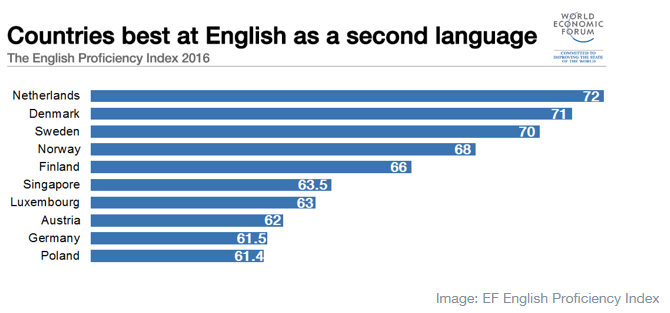
Nevertheless, many beautiful countries rich in culture and tradition are a bit behind on the proficiency index. And, even the most proficient countries might only be proficient in bigger metropolitan cities where tourism drives the economy. It’s much easier to explore quaint little towns, to participate in authentic cultural rituals and ceremonies, and to really connect with people from other cultures when you speak their language.
Check out the images below to see the English language proficiency of countries all around the world.
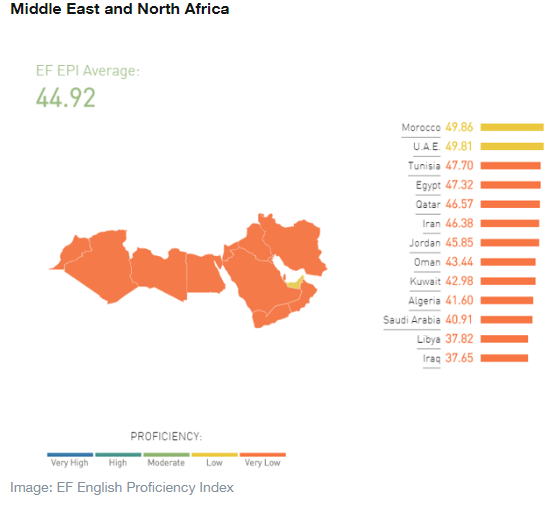

Luckily, native English speakers can choose their second language
Native English speakers also have a second advantage. While speakers of other languages are basically required to learn English as there second language, native English speakers have more freedom to choose which language to study as their second language.
For children, what language they learn is really up to their parents. Parents whose native language is not English often teach their children their own native language. By doing so, it’s easier to be involved in the child’s learning process; these parents don’t need to hire native speakers to come speak to their children, for example. Furthermore, their children can more easily connect to their own heritage.
But for young children who come from monolingual English speaking families, parents often must decide what language they would like their child to learn from a long list of possibilities. Will they learn Spanish? Mandarin? Portuguese? Arabic? Some languages are more popular around the world than others and are therefore more useful.
The image below illustrates the most popular languages in each continent around the world.
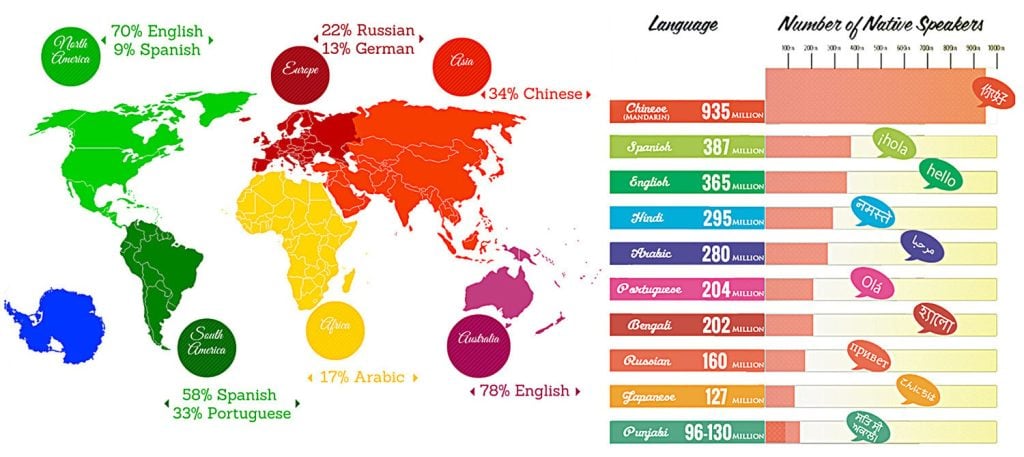
12. Learning a second language prevents future age-related illnesses
Many studies have hypothesized that people who speak a second language regularly may be able to delay Alzheimer’s disease by 4.5 years.
New research published in the journal Neuropsychologia reveals that bilingualism makes changes in brain structure that are linked with resilience against Alzheimer’s disease and mild cognitive impairment.
Researchers reason that this is due to the constant workout that a bilingual brain experiences as they constantly filter through information in two languages.
Click here to read to full article.
What have we learned? – 12 key points
There are 5 main benefits of learning a second language at an early age.
- Learn faster and easier
- Improve problem solving and creativity
- Enhance future career opportunities
- Connect with other cultures and build tolerance
- Prevent age-related mental illness
This is why:
- Our brains are designed to learn languages before we reach puberty. It’s a good idea to start learning as early as possible.
- Babies can differentiate all the sounds of language before 10 -12 months then they start to lose this capacity according to the sounds they find useful (their own language). Therefore, it’s good to expose babies to many different languages so they retain this ability.
- Children think more simply and therefore have less to learn. They don’t get overwhelmed while attempting to communicate complex thoughts like adults do.
- Children have much more time to dedicate to language learning. Learning is their full-time job.
- Bilingual brains experience a non-stop, full mental workout.
- This brain exercise leads to improved planning, problem-solving, concentrating, and multitasking.
- This brain exercise also contributes to divergent thinking – out of the box thinking and problem-solving skills.
- Bilingual children are more creative.
- Learning a second language leads to improved test scores during childhood and adolescence.
- As children get older, their bilingualism can help them get jobs and earn higher wages.
- They’ll also have more opportunities to travel, connect to their heritage or get to know other cultures.
- Finally, as they approach old age, their bilingualism will have the capacity to slow the onset of Alzheimer’s disease by 4.5 years.
About Ertheo
Ertheo is a sports and education agency dedicated to empowering young athletes to reach their full potential as athletes and upstanding citizens.
As part of our mission, we offer only the best sports-education programs in the world.
Our team is available to answer all of your questions and offer expert advice.
Call us at (+44) 203 769 94 43 or (+34) 902 750 359.


